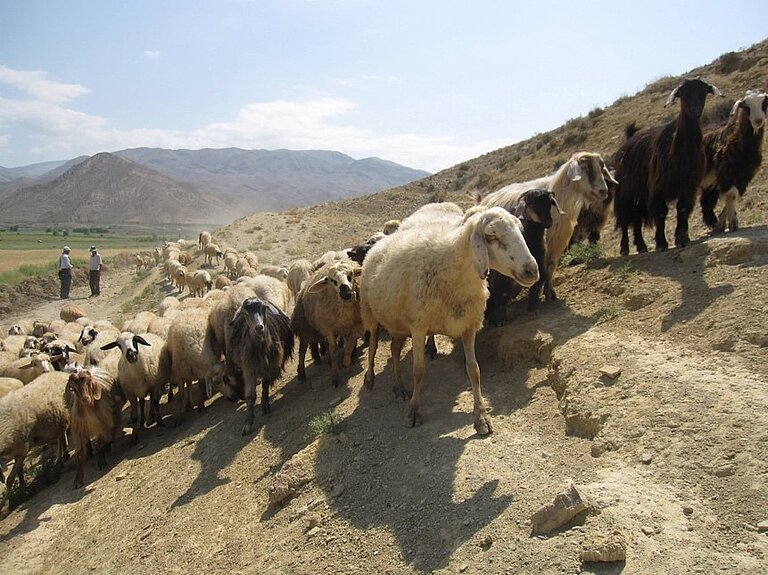Milk in prehistory
Milk is an exceptionally nutritious food source, rich in protein, fat, sugar (lactose), vitamins, and minerals such as calcium. Although milk itself is perishable, it can be converted into more stable products such as yogurt, curds, cheese, and butter through microbial fermentation and other forms of manipulation. Such products can also be stored for longer periods of time, allowing people to consume dairy products year-round. Moreover, the ability of livestock to reliably convert grasses into milk allows people to expand into environments that are otherwise marginal for human habitation. The story of milk is one of human innovation and adaptation, but much about its early prehistory remains poorly understood.
There is a long debate in archaeology as to how dairying first arose and spread, with evidence of milking in the Near East as early as the Neolithic period in the 7th millennium BCE, and later in southeastern Europe by the 6th millennium BCE and East Africa by the 4th millennium BCE. In Eurasia, the picture has been less clear, although it certainly reached Mongolia by ~3000 BCE and was practiced in western China by ~2000 BCE.
The dispersal of dairy technologies into Asia was facilitated by the steppe, a vast expanse of grasslands stretching 6,000 km from the Carpathian Basin to Mongolia. Bronze Age mobile pastoralists from the North Caucasus steppe played a key role in spreading dairy technologies into Asia, expanding eastwards with their wagons and dairy livestock in the late 4th millennium BCE. However, little is known about how dairying arose in the North Caucasus, or what motivated these ancient societies to drive their dairy herds thousands of kilometers eastwards.
The rise of dairy pastoralism on the steppe
In a study published on 7 April 2022 in Nature Ecology & Evolution, an international team of researchers applied paleoproteomics to analyze the dental calculus of individuals from the North Caucasus steppe and surrounding regions spanning a period of 6,000 years. Tracing milk proteins back through time, they identified the spread and arrival of dairying technologies to the North Caucasus from the south in the late 5th millennium BCE, and documented the changing use of dairy livestock through time, ultimately finding that past steppe societies had milked sheep, goats, cattle, and horses at different periods in the region’s history.
The team confirmed that dairying arrived in the North Caucasus alongside the earliest evidence for animal husbandry, suggesting that livestock and dairy technology spread as a package already during the Eneolithic, and as early as 4200 BCE. Dairying continued throughout all subsequent periods and among all cultural groups, but it changed through time – beginning with a focus on sheep milk among the Eneolithic, Maykop, and early Yamnaya groups, and later diversifying to also include goat and cattle milking from the early 3rd millennium BCE onwards among the late Yamnaya, North Caucasus Culture, Catacomb, and Lola groups. In the South Caucasus, dairying was detected intermittently from the Chalcolithic (~7,500-5,500 BCE) onwards, but dairying arrived rather late – after 2500 BCE – in the forest-steppe to the north and regions east of the Urals.
The importance of sheep
The lack of cattle milking among the Maykop was unexpected given that Maykop material culture so strongly focuses on cattle-associated imagery and equipment, including bull figurines, cattle nose loops, and even burials containing entire oxen teams. By contrast, the perishability of sheep secondary products, such as milk, cheese, and wool, has made sheep less visible in the archaeological record, and this appears to have contributed to a biased understanding of the relative importance and roles of different livestock at Bronze Age Eurasian sites.
The transition from sheep dairying to a more diversified dairying strategy based on sheep, goat, and cattle milk products first occurred during the height of the Yamnaya period in the early 3rd millennium BCE. The Yamnaya were the first cultural group to become fully and permanently mobile, utilizing wagons to spread across the entire Pontic-Caspian region and beyond. It could be that the need for additional pastures to support these herds, especially as the climate became drier after 3000 BCE, may have driven the heightened mobility of the Middle and Late Bronze Age periods. Although Yamnaya-related groups were a major factor in the spread of dairying technology across Eurasia, we find that they inherited a regional dairying tradition and other key innovations, such as wheeled wagons allowing them to sustain a mobile lifestyle, that had already been underway for a millennium prior to their expansions.
The late emergence of horse milking
Notably, horse milking was only observed at a 9th century BCE Iron Age cemetery of pre-Scythian nomads. This cemetery was related to the recent repeopling of the North Caucasus steppe after a centuries-long hiatus caused by a catastrophic drought that began ca. 1700 BCE. Despite the fact that domesticated horses trace their origin to the North Caucasus steppe, this finding suggests that horse milking was not a local innovation, but rather was introduced during the Iron Age. Nevertheless, the region became widely known for its horse milking, and at the time, the Greeks referred to this region as being populated by ‘horse milk drinkers.’ Today, the fermentation of mare’s milk to produce the alcoholic beverage kumiss is an integral aspect of cultural heritage on the Eurasian steppes.
###
This research is part of a collaboration between the Eurasia Department of the German Archaeological Institute and the Max Planck Institute for Evolutionary Anthropology in Leipzig under several ERC grants - ARCHCAUCASUS (Svend Hansen), PALEoRIDER (Wolfgang Haak), and DairyCultures (Christina Warinner).
Contacts:
Sandra Jacob
Public Relations & Press Office
Max Planck Institute for Evolutionary Anthropology, Leipzig
+49 341-3550 122
jacob@[>>> Please remove the text! <<<]eva.mpg.de
Prof. Dr. Christina Warinner: warinner@[>>> Please remove the text! <<<]fas.harvard.edu
Dr. Wolfgang Haak: wolfgang_haak@[>>> Please remove the text! <<<]eva.mpg.de
Prof. Dr. Svend Hansen: svend.hansen@[>>> Please remove the text! <<<]dainst.de
